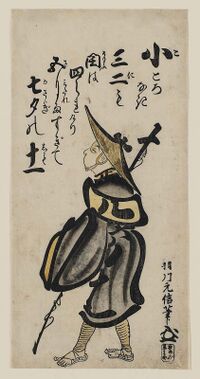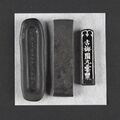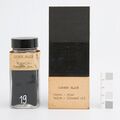Carbon black:Ukiyo-e colorant
Carbon black 墨 (sumi): A fine particle carbon pigment obtained as soot from the incomplete combustion of many different types of organic materials. In Japan, the two main types of carbon black are lamp black and pine soot black. The soot is mixed with animal glue (膠 nikawa) to produce ink sticks. Lamp black (油煙墨 yuen boku) is made from burning Rapeseed oil or Sesame oil as well as other oils. Pine soot black (松煙墨 shōen boku) is made by burning pinewood. While the color can range from a brownish to bluish black, lamp blacks are usually dark black and pine soot blacks are bluish black.
Carbon black can be printed to produce a range of gray to blacks. It can also be added to other colorants to darken the color. On early hand-colored prints called urushi-e (漆絵), animal glue was added to carbon black, which gave it a sheen like lacquer, or urushi. The lines of the key-block and printed black areas are most likely lamp black. Black areas are sometimes manipulated by embossing or burnishing to create patterns within the area and/or to create a sheen, and is frequently used to depict lacquerware. Bluish gray areas which do not produce an analytical result of blue, may be an indication of pine soot black either used alone or mixed with one of the whites.
For additional information see: Carbon black, Lamp black, Pine soot black
Analysis
Raman spectroscopy can be used to identify carbon black but black as a single colorant or in a mixture was not analyzed in this research.
Images of Carbon black
This category currently contains no pages or media.






